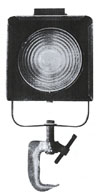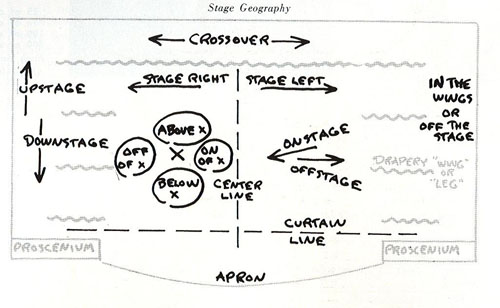
BY TOM SKELTON
courtesy of
Dance Magazine
first published
October 1955

Part I
INTRODUCTION
Dancers are a hardy lot. Otherwise how could they see the wild assortment of stages the American theatre offers them and still have the courage to start the rehearsals that lead to performances.
I have seen many theatres, representing investments of thousands of dollars where the janitor has kindly waxed the floor; where the expensive but embarrassing electrical curtain rattles closed at a snail’s pace; where the ornate doorway in the back of the stage wall cannot be masked by drapery; where the brand new lighting equipment does not yet have bulbs; where the gold lame draperies make it very difficult to concentrate on the dancer; where the class rooms in the next building must serve as dressing rooms; where the high school boys used screw drivers to open the spotlights; where the architect failed to plan a way to reach the auditorium ceiling spotlights; where the switch for the red footlight is in the star dressing room and the blue and white switches are behind the two pianos that are stored behind the stage; where the janitor who has the key to the equipment room is off for the day; where the band department’s stored kettle drums and basketball apparatus jut out onto the stage, where you can never see the lower half of the dancer’s body from the audience.
Nor is the professional theatre any better off. Real estate value usually cramps the stage area impossibly, and high rental makes proper equipment unfeasible. The only advantage is the experience of the designers and crews who have somehow tightroped their way around some of these basic problems and often still have enough imagination to aim at perfection. Do these things discourage the dancer? Never. It’s an admirable spirit. But, too few dancers realize they must master lighting, stagecraft, and costuming, as well as the barre. For while the actor should, and often does, understand these tools, there are also well-established basic techniques and sensitive experts in the theatre to fill his ordinary needs. But not so with dance! I hope in these articles to discuss some of the non-dance of dancers in performance and offer suggestions which, combined with his indomitable imagination, may help him achieve a greater artistic freedom through familiarity with the technical problems he faces every time he gives a performance.
LIGHTING
Most dancers today seem to be very much concerned with their lighting, which is as it should be since good lighting can be a very expressive tool. While it may not be true that good lighting can “make” a dance great, it is certainly true that good lighting can make a good dance better, and that bad lighting can ruin even a fine dance.
There are many barriers between the dancer and good lighting, but each can be hurdled with enough imagination, common sense, and perseverance – attributes no usually lacking in a dancer. The obstacles, basically, are three:
1.) Inadequate theatres with inadequate lighting equipment. Despite the numerous university and professional theatres with enough equipment so that “only imagination is needed to use it properly,” the majority of American auditoriums have not yet come out of the footlight-and-border period of gaslight development. The gaslights have been converted to electricity, but the resultant lighting is more or less the same: distortion of the footlights, brightness at the top of the drapery or drop that pulls the eye away from the dancer, and somehow there’s never enough light, even when the glare is blinding. Solution: Although bad facilities and lack of technical assistance are powerful enough reasons to drive the less-than-dedicated dancer out of the field entirely, they are frequently only an excuse for a lack of imagination. Gooseneck lamps, borrowed photofloods and many other improvised spotlights (which I will discuss in detail later) can substitute quite adequately for expensive equipment. And a little experience with substitutes will better prepare the dancer to take full advantage of good equipment and good technicians when the opportunity arises.
2.) The fact that ballet usually done in repertory often means that one performance may require several entirely different approaches in the lighting to meet the requirements of the several different ballets. Solution: A set-up that assures you of a good basic dance lighting for all types of dance, with enough flexibility to permit you to solve the special needs of each ballet.
3.) Inadequate precedent in dance lighting. The various time-proven theatre techniques have often by-passed the very special requirements of dance. There are very few technicians who have specialized in dance lighting, so if the dancer is lucky enough o have trained technicians at all, the chances are that the technician brings with him a set of pretty definite opinions based on experience in drama lighting, which are only slightly applicable to dance lighting. Solution: The dancer must have enough understanding of the established theories of stage lighting so that when he suggests deviations for the special requirements of dance his technicians can understand both the method and the reasons. I remember a dance production at a university where the lighting designer, recognizing the fact that his dance lighting must be different than his drama lighting (a field in which he did not lack experience), accomplished the transition simply by deepening the colors of his regular style of lighting. All of the ballets that evening became quite ludicrous under the heavy magenta and pale green set-up, the make-up and costumes which had been so carefully hand-dyed were destroyed completely. But he must not be criticized too harshly, for his attitude is no different from many of the theatre’s most talented and experienced technicians who do not take dance very seriously, believing that all it requires is more and richer color, like a nightmare section of an expressionistic German drama of the 30’s.
If a choreographer talks to a fledgling designer in terms of “murky reds” and “cold streaks that push me down,” or remarks that “now remember, dance is different” with no further elaboration – then he will deserve what he gets in t4erms of bad lighting, patronization, and little cooperation. Every play director knows exactly which scenes require relative emphasis, which parts of the stage are most important and when, where shadows are distracting and where they are helpful – and he can quietly explain this to his technicians, and can usually suggest methods of achieving it. True, dance is more abstract and cannot so easily be pinned down, but if the choreographer does not understand his work well enough to be able to explain it in terms of light, he certainly can’t expect clairvoyance from his non-dancing technician.
Not that dancers must know all of the technical details of stage lighting, for rarely is he required to hang and focus the spotlights himself, but he must be able to tell his technicians where he wants the “streaks of cold light” to land on the stage floor so as to help rather than destroy the choreography. And he must know enough about the possibilities and limitations of stage lighting to be able to look at the result critically to be sure he’s getting proper visibility, mood, and emphasis in relation to the choreography. The unfinished costumes, broken leg of the leading dancer, and the unrehearsed curtain calls are apt to prove distracting to the choreographer at the lighting rehearsal the night before the performance, unless he has prepared himself instinctively to recognize good lighting with the same diligence with which he knows when he is “turned out.” When all is said and done, it’s his responsibility, and only his responsibility, for only he knows what he wants the choreography to say.
Next month we’ll discuss stage lighting as a preliminary to dealing more specifically with dance lighting. Each month I will introduce additional words of a technical nature, hoping that, if you are not already familiar with them, you will study them diligently to prepare yourself to better understand later articles. The illustration on page 61 deals specifically with directions, or stage geography

If the dancer is standing on “X,” facing the audience, he is surrounded by a backdrop curtain, three “legs” or “wings” on his right and three “legs on his left. If he moves all the way across the stage to his left (to Stage Left) he is “crossing onstage,” and finally exits “into the wings” or “off the stage.” Since the original stages were slated [sic] towards the audience to permit better visibility, the terms “upstage,” “downstage’” “above,” and “below” all derive from this ancient convention (not so ancient, as a matter of fact, considering the fact that Philadelphia’s much-used Academy of Music still has a slanted stage.)
(continued next month)